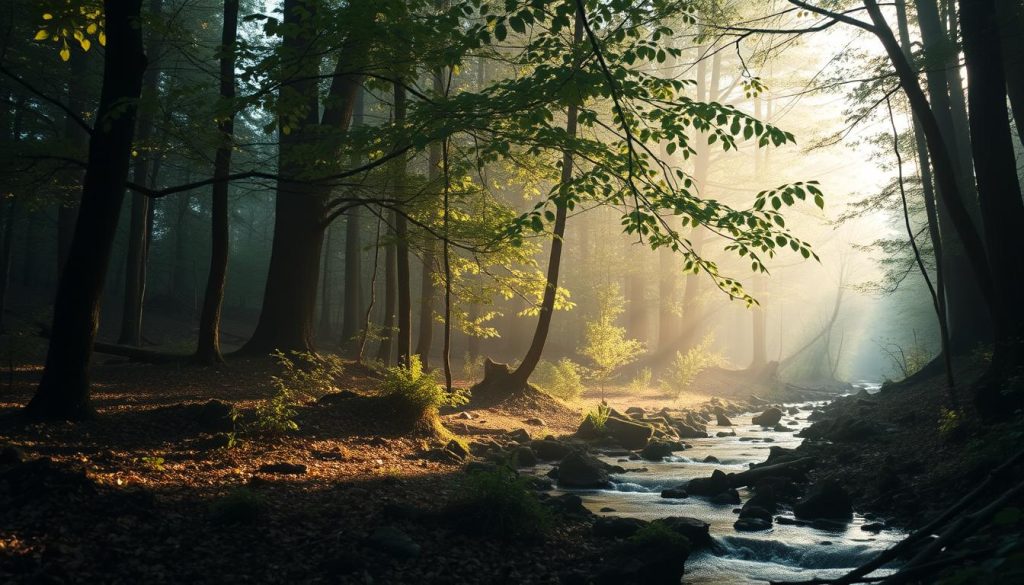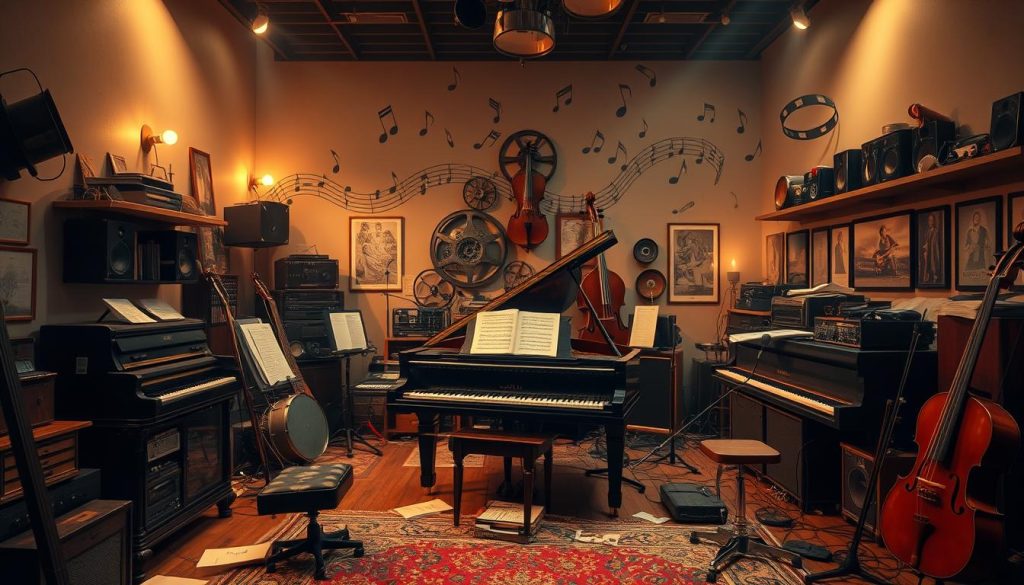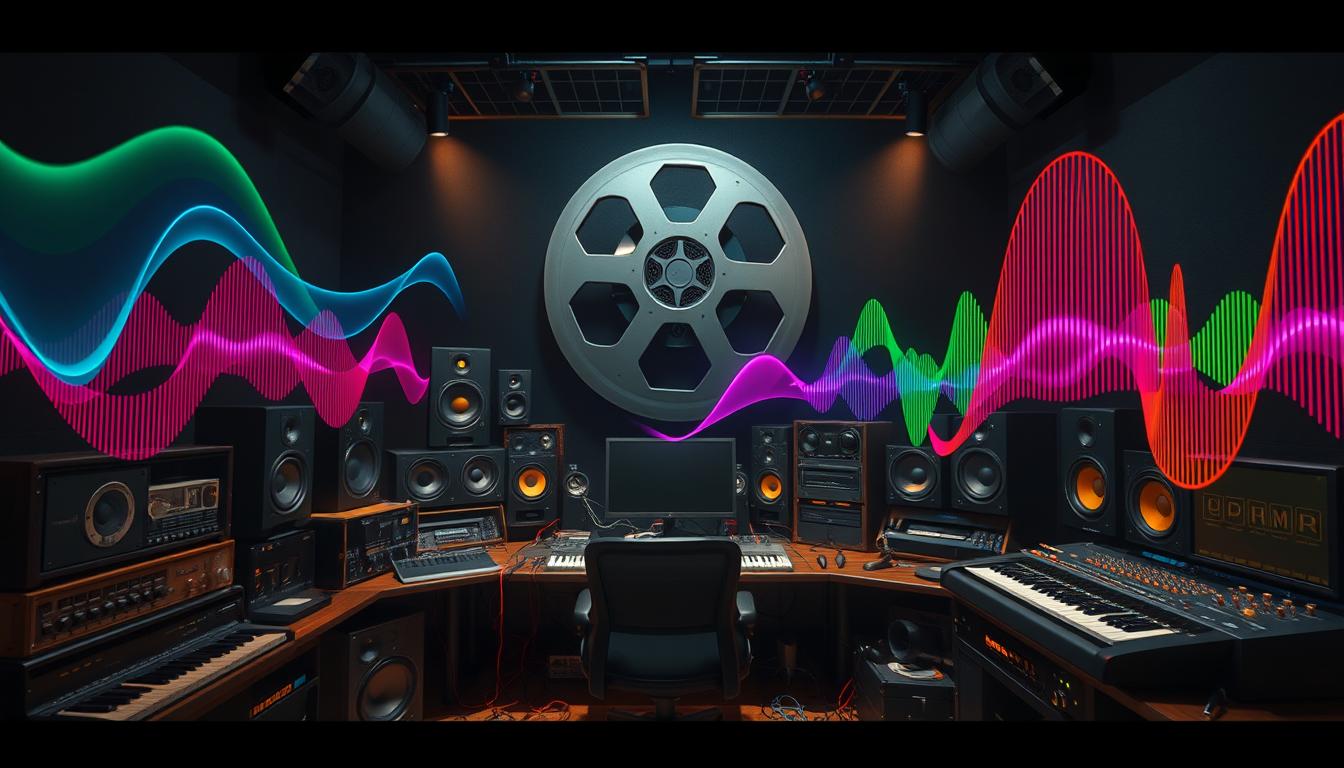I love films and always notice how sound makes them come alive. Sounds take us to new places, make us feel things, and spark our dreams. This article will look at how film sound design does this and why it’s so important.
Film sound design mixes different sounds like effects, dialogue, and music. It makes a movie’s sound world. Sound designers use these sounds to change how we see things, make scenes feel more real, and control the movie’s speed.
Imagine hearing a ghost’s soft whispers or a dragon’s loud roar in a movie. These sounds take us on journeys and touch our feelings in ways visuals can’t. Making these sounds is a mix of skill and creativity. Sound designers work hard to make sure the sounds fit together perfectly.
We’ll look closer at film sound design soon. We’ll see how it makes us feel, the ways to make unique sounds, the role of ambient sounds, and how music adds to the movie magic. Let’s explore the magic of film sound design together.
The Art of Film Sound Design: Transporting Audiences to New Worlds
I love how film sound design works its magic. It takes us to new places and makes us feel things deeply. From a dragon’s roar to a lover’s whisper, sound design makes movies come alive.
What is Film Sound Design?
Film sound design, or audio mixing, blends different sounds into one immersive experience. It includes adding sound effects, making dialogue tracks, and picking music that fits the movie’s mood. This process is key to making a film stand out.
The Power of Sound in Evoking Emotions
Sound design can make us feel things deeply. It can make action scenes more intense, build suspense, and connect us to the story. The right sounds can turn a good movie into one we’ll always remember.
Let’s explore film sound design techniques and the art of sound design in filmmaking. We’ll learn about the secrets of creating amazing auditory experience in cinema. From soundscapes to Foley effects, we’ll see the magic of cinematic sound design.
Mastering the Techniques: Soundscapes, Foley Effects, and Cinematic Music
I love making soundscapes that take people to new places. These are the sounds around us in a scene or location. It’s a big part of my job.
Crafting Unique Soundscapes
I mix different sounds like footsteps and background noises to make a believable soundscape. This makes the scene feel real and pulls the audience in. It also sets the mood and makes them feel things.
The Art of Making Silence Speak: Unmasking Foley
Foley effects are key too. They’re everyday sounds recorded to add a human feel to the movie’s sound. Things like gravel crunching or clothes rustling make the soundscape feel real.
Then, there’s the magic of film music. I mix music to set the mood, make people feel things, and make scenes stand out. Music, whether it’s heard in the scene or not, is what makes the movie special.
I’m always finding new ways to use soundscapes, foley, and music in movies. My goal is to make movies that leave a lasting impression on viewers.
Whispers of Place: The Power of Ambient Sounds in Film

In film sound design, making ambient sound design in film is key. Sound designers use field recording and other techniques. They create environmental sound effects that take viewers right into the movie world.
Immersive soundscapes are crucial but often overlooked. They shape the movie’s mood and make the experience better. By mixing sounds from nature and more, sound designers make the movie feel real.
From quiet forest sounds to city noises, these sounds set the movie’s mood. They help tell the story and make viewers feel like they’re there. This makes the movie more memorable.
Sound designers are true artists. They use environmental sound effects and immersive soundscapes to create magic. Their work is key to the movie’s success and magic.
The Heartbeat of Cinema: The Value of the Film Score

The film score adds music to movies, making them feel more emotional. It uses instruments, melodies, and rhythms to move us. This music takes us on a journey of feelings, from happiness to sadness.
Elevating the Emotional Impact of Soundtracks
The score matches the action on screen, making scenes feel more real. It connects us to the story in a special way. A great film score can make us feel more scared, happy, or nostalgic. It mixes with the pictures to make a complete movie experience.
The Symphony Within the Scene: Diegetic & Non-Diegetic Sound
Knowing the difference between diegetic and non-diegetic sound is key for movie makers. It helps them use sound to tell the story better. Using diegetic and non-diegetic sound can make scenes more emotional. It helps guide our feelings and what we think about the story.
The film score is the heart of movies, adding a musical beat. It makes movies more powerful by creating deep feelings in us. Filmmakers use emotional impact of movie soundtracks to take us on amazing journeys.
film sound design: Revolutionizing Cinematic Soundscapes
I love being a film sound designer. I’ve seen how much the movie experience has changed over time. Sound mixing, or audio mixing, has grown a lot. Now, filmmakers can make sounds that pull audiences into new worlds.
3D sound technologies like Dolby Atmos and DTS:X are big news in film sound. They let sounds come from all directions, even above you. This makes the movie feel real and more exciting. Filmmakers use these sounds to make viewers feel like they’re part of the action.
Sound design keeps getting better, making movies more engaging. Sound designers create unique sounds and use silence to tell stories. With 3D sound, movies now pull us deeper into the story. This changes how we watch and feel about movies.

